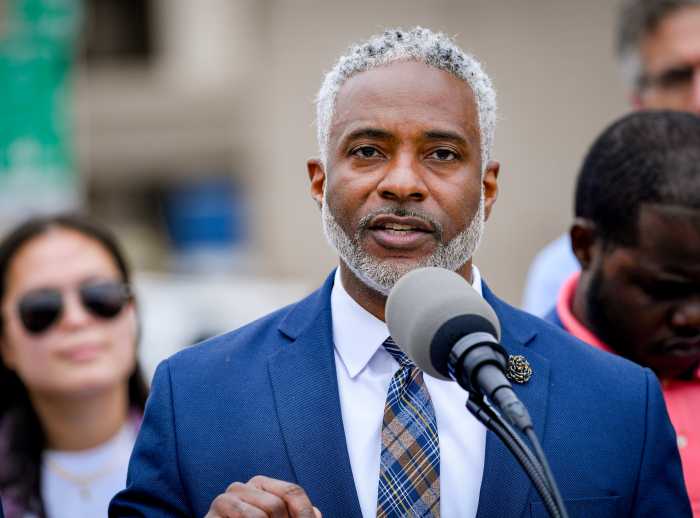BY SAM SPOKONY | As many city activists and officials continue to call for the construction of storm barriers or new seawalls in the wake of Hurricane Sandy’s devastation, urban planning experts gathered at The Cooper Union last week to discuss ideas for community and infrastructure-based solutions to the problems that the city’s coastal areas must now confront.
The Jan. 10 panel discussion, which drew a full-house audience to the Great Hall of Cooper’s Foundation Building, was jointly organized by the Two Bridges Neighborhood Council, the Cooper Union Institute for Sustainable Design and the Architectural League of New York. The forum’s title, “The Future of Zone A: New York Neighborhoods on the Frontline of Climate Change,” referred to the primary flood zones identified by the Mayor’s Office that were under mandatory evacuation orders before Hurricane Sandy.
In terms of the tangible design responses, Susannah Drake, a founding principal of the dlandstudio and senior associate of the Cooper Union Institute for Sustainable Design, discussed ideas for more water-permeable streetscapes within Lower Manhattan.
Drake said that she’s currently working on a project, sponsored by the Museum of Modern Art, that would create wetlands around coastal areas. She explained such adjustments could help prevent flooding by complementing potential plans for green infrastructure and new gardens, in order to allow flood waters to flow in and out of Zone A streets without causing destruction. In addition, Drake explained that the city might have to re-evaluate its own restrictions on infrastructure planning in order to facilitate those types of designs.
“We need an overall strategy for managing storm water, and maybe that will have to includes changes to jurisdiction and regulations currently in place for the Department of Transportation and the Department of Environmental Planning,” she said.
Those current restrictions were also highlighted by Claire Weisz, a principal at WXY Architecture and Urban Design, who pointed out the inherent difficulty of trying to incorporate more natural flood barriers and wetlands into the city’s already crowded environment.
“There’s a tension between doing these natural edges and ceding space, because you can’t go out in the water due to current regulations,” she said. “There’s an urge to use every inch space [for development], but that’s not always a good thing now, considering the impact of climate change.”
The forthcoming redevelopment of Pier 42 — the currently vacant 8-acre space that sits along the East River waterfront, just past the intersection of Montgomery and South Sts. — was mentioned several times during the Cooper Union panel discussion.
Culhane has argued that the pier’s eventual park could be an important starting point for implementing the aforementioned green infrastructure tools for flood management purposes. In particular, she said, any ecological designs on that small scale could become a model for the city’s other coastal areas that are seeking answers to the questions raised by Sandy.
Pier 42 had undergone two failed attempts at redevelopment, in 2005 and 2009, but around $16 million in new capital funding has allowed the city to try turning the pier into a park once again. Mathews Nielsen, the landscape architect firm hired by the city’s Parks Department to design the project, has said that it hopes to have a master plan in place for the pier by March.
And after several delays, a second community forum, in collaboration with Community Board 3, will be held on Wed., Jan. 23, to allow local residents to provide input on what they’d like to see in the pier’s redevelopment. The first forum was held in October — just weeks before Sandy struck — and was not very well attended by community members.
That could change this time around, given newfound concerns about waterfront development. But in an interview with this newspaper several weeks after Sandy’s flooding devastated the area, Signe Nielsen, principal of Mathews Nielsen, said that she hopes residents don’t become reluctant to suggest ideas regarding new structures on the pier, since the proper planning should allow for sustainable construction.
“I just don’t want people to become too cautious, because we always design for flood resiliency, and we know that will be particularly important in this case,” Nielsen said. “We can design something that won’t be destroyed, but focusing on elevating the site and making sure that water can flow through a structure without crippling it.”
She also highlighted the neighborhood-centric aspect that was later stressed at the Cooper Union panel, explaining that community input on the project remains vital, and could have added, intangible benefits.
“I’m glad that this is becoming a larger conversation, and I hope it’s a wake-up call, that we need to think more seriously about what our shorelines can or can’t do,” Nielsen said. “And I would love this [Pier 42] project to be therapeutic, to help the community work through the ordeal and understand that if we design it right, this park won’t be subject to the kind of problems that so many homes and other buildings faced during the storm.”




































